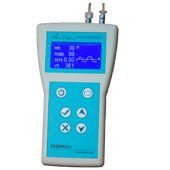Respiratory Monitors
FluxMed GrH

The FluxMed GrH main features:
- Portable
- Power Supply: 2 x AA Battery
- 21 Parameters
- 3 Signals
- Tendency Graph
- Recruitment Maneuvers
- Pimax – Pemax – P0,1 Measurement
- Signals Records
Measuring respiratory parameters in a fast, reliable and simple way, allows to reduce treatment times, health service costs and significantly improve the quality of medical care.
The FluxMed monitors calculate the parameters based on flow and pressure measurements. They use a disposable flow sensor designed to be connected to the equipment in a simple and fast way and is fully compatible with masks, endotracheal tubes and tracheotomies.Small and lightweight, the FluxMed GrH is specifically designed as a portable device. It works with rechargeable or common batteries and has a good autonomy.
Due to its great maneuverability, the FluxMed GrH helps the professional to perform routine rounds of measurements more quickly and is ideal for monitoring patients during transport.
Ventilated Patients
FluxMed GrH respiratory mechanics monitor can be directly connected to an intubated and ventilated patient in assisted or controlled ventilation, enabling a detailed analysis of synchronicity between the patient and the respirator.
Weaning
FluxMed GrH respiratory mechanics monitor shows the most important parameters on screen to help determine the success of a patient’s weaning. It makes it possible to carefully carry out a patient’s follow-up, in the process of not needing further respiratory assistance.
T-tube test
Respirators lose monitoring capacity once they are disconnected from the patient. The FluxMed monitor allows to continue the monitoring of respiratory mechanics during T-Tube tests, allowing the professional to know the evolution of the respiratory mechanics of the patient during the test.
Flow Sensor
The flow sensor is designed to perform a proximal measurement, thus avoiding the error produced by the distensibility of the respiratory tubes.
Non-Invasive Ventilation (VNI)
It is particularly useful for monitoring ventilated patients in a non-invasive way. The flow sensor easily adapts to face masks making it possible to monitor patients with CPAP or BIPAP.
Spontaneous Respiration
Connecting the flow sensor to a mask allows spontaneous-breathing monitoring, thus easily obtaining accurate readings of the patient’s condition making it possible to objectively choose whether there is or not a need to intubate and mechanically assist breathing. It allows for a thorough follow-up of the patient.
PC Connectivity (Optional)
FluxMed GrH respiratory mechanics monitor comes with an optional USB data transfer connector, making it possible to record long lasting examinations with measurements and tendencies of the calculated parameters.
MBMED: Av. Santa Fé 1955 (B1640IFG) Martinez, Bs. As., Argentina Phone: +54 11 5258 8787 Email: info@mbmed.com